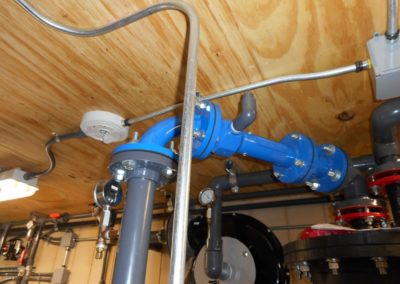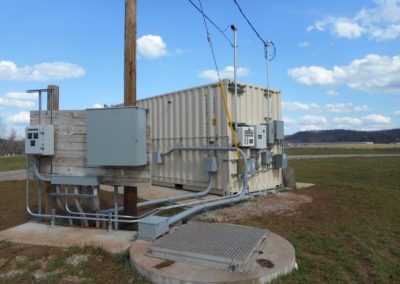Theia Cleans Up Iron & VOC’s… Again
Site location: West Virginia
Challange: A major US chemical company has a site in West Virginia that requires groundwater treatment. As with many sites, while organic contaminants were the main target of the cleanup, iron and manganese in the groundwater were the major challenge.
Adding to that challenge:
- The site is very large and has three extraction points thousands of yards apart.
- The discharge location is a great distance from the three extraction points
- The levels of iron is too high (60 mg/l of iron) to allow for the transmission of the water from the extraction point, even with the use of sequestering agents or nitrogen blanketing
- The site itself is somewhat remote and no longer active. Thus a system that was simple with low maintenance was a requirement
Solution: The consulting engineer tasked with designing the treatment system evaluated a number of options, however, Theia’s OxyStrip system is the only system that can strip volatile organic compounds and directly oxidize iron and manganese using nothing but air.
Most Iron and Manganese treatment systems are complicated, require regular attention, and generate a large volume of sludge. This sludge would require the storage of iron sludge and periodic removal of the sludge via vacuum truck. The iron sludge would also contain contaminated groundwater making the disposal costs high.
The Oxystrip system is so simple and effective, it is something that customers need to see for themselves. A small simple pilot skid system was brought to the site to test the technology. They ran a detailed and thorough pilot test of the technology at the site and the system proved even more effective than had been promised. The test was so convincing that they recommended to their client a full scale system. The full scale system would consist of three (3) OxyStrip systems at the collection areas and a final polishing system at a central location.
One of Theia’s largest to date, this project is comprised of four systems, spaced thousands of feet apart, which are designed to remove Iron and VOC’s from the groundwater at an industrial site in West Virginia. Three of the systems are identical Iron Removal systems utilizing our OxyStrip system. The OxyStrip system features our Oxygenator technology which oxidizes iron and other compounds (such as manganese and sulfides), while stripping most VOC’s and other compounds that have weaker Henry’s constants (such as carbon dioxide). Water is drawn from a vault that is present at each of the systems. The water then enters the stripping tank and is continuously circulated through the Oxygenator to achieve the desired removal efficiency before progressing further. The next stage of the OxyStrip system promotes settling as chemicals are mixed into the water to facilitate the precipitation of solids. The solids accumulate and settle as a sludge in the quiescent chamber of the stripping tank. From the settling process, the water is pumped through a bank of sand filters to remove any iron that fails to settle, and out of the system to the next vault. The filters are set up in parallel to allow for backwash while the system is still in operation. The backwash from the sand filters, along with the sludge from the stripping tank, is sent to the dewatering system. This system includes a dewatering box and a Geotube, which acts like a bag filter but provides many times the surface area and volume, allowing the water to slowly pass through the large filter. The Geotube purges the water from the sludge until it is dry enough to be removed and disposed of as a solid.
The three Iron Removal systems are set up in series so the partially treated water is conveyed from vault to vault before the last stage of treatment. The fourth and final system is the Liquid Carbon system. It accepts the partially treated water from the three Iron Removal systems and passes the water through an Organoclay media vessel and two Liquid Carbon vessels containing our Virgin Coconut Shell Carbon media to remove the remaining VOC’s. The treated water is then discharged to a nearby body of water.
The project was installed in two stages, one in the summer of 2015, which became operational in the fall of 2015 the second in the summer of 2016 and has been in operation since September.








